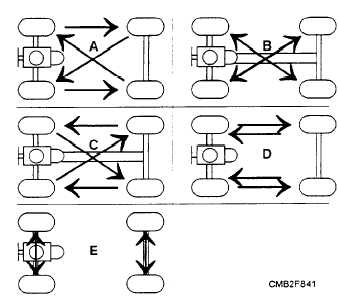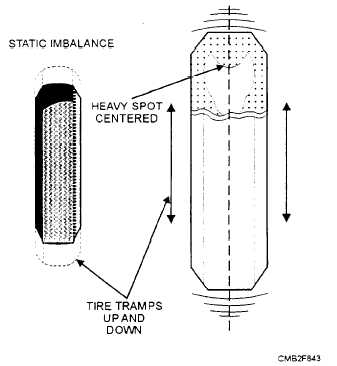
Figure 8-41. - Tire rotation diagrams.
When your tires wear out together, you can get a new set of tires without being forced to change tires in pairs. By replacing tires as sets, you will maintain the original handling balance.

Figure 8-42. - Dynamic imbalance.
Wheel Balancing
Improper wheel balance is the most common cause of tire vibration. Often a tire will appear to be round and true when rotated slowly. However, when one side is heavier than the other. centrifugal force tries to throw the heavy area outward during operation. To obtain maximum tire wear and a comfortable ride, you should balance the wheels. The two types of tire imbalance are as follows:
DYNAMIC IMBALANCE (fig. 8-42) lies on either or both sides of the center line of the tire, which causes the tire to vibrate up and down (wheel hop) and from side to side (wheel shimmy). To be in dynamic balance, the top-to-bottom weight and the side-to-side weight must all be equal.
STATIC IMBALANCE (fig. 8-43), also called wheel tramp or hop, lies in the plane of wheel rotation, which causes the tire to vibrate up and down. For a wheel and tire assembly to be in static balance, the weight must be evenly distributed around the axis of rotation.
To static balance a wheel and tire assembly, add wheel weights opposite the heavy area of the wheel. If a large amount of weight is needed, add half to the outside and the other half to the inside of the wheel. This will keep the dynamic balance of the tire. However. when dynamically balancing a wheel and

Figure 8-43. - Static imbalance.
tire assembly, the weights must be added exactly where needed (fig. 8-44).
A wheel-balancing machine is used to determine which part of a wheel assembly is heavy. The three types of balancing machines are as follows:
BUBBLE BALANCER (fig. 8-45) is the most common type of balancer used by the NCF. This type of balancer will ONLY statically balance a wheel 8-38Continue Reading
